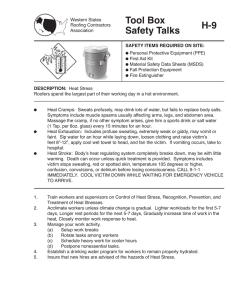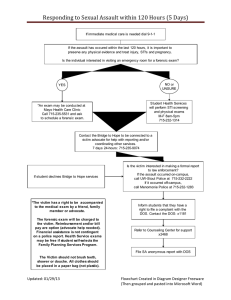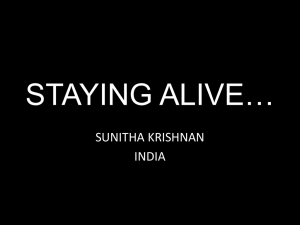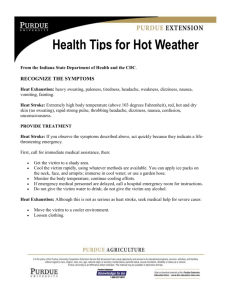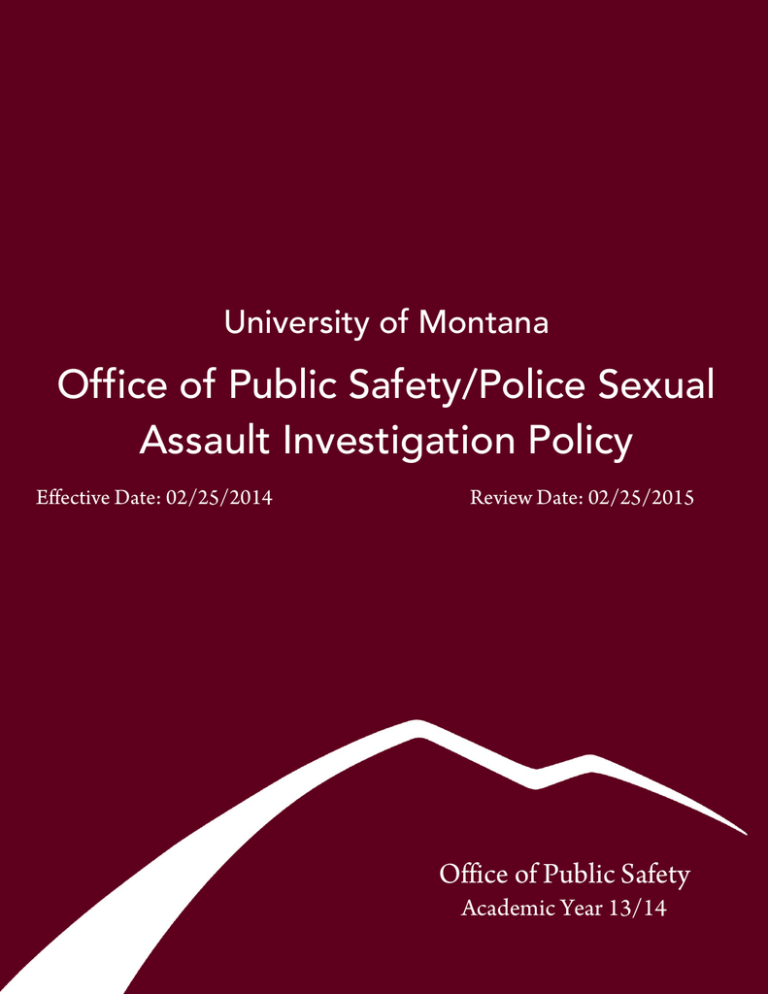
University of Montana
Office of Public Safety/Police Sexual
Assault Investigation Policy
Effective Date: 02/25/2014
Review Date: 02/25/2015
Office of Public Safety
Academic Year 13/14
University of Montana
Office of Public Safety/Police Sexual Assault Investigation Policy
I.
PURPOSE
The purpose of this policy is to provide officers and investigators with guidelines for responding to
reports of sexual assault, sexual intercourse without consent, assisting victims, collaborating with local
health, outside law enforcement and service agencies, and conducting interviews with victims, witnesses,
and suspects. Because of the special needs involved in sexual intercourse without consent investigations
an attached appendix serves as an all-inclusive document that covers first response, investigation and
prosecution.
II.
POLICY
Trauma from crime victimization complicates a victim’s participation in the investigation. The trauma
may be so overwhelming that a victim cannot function well enough to assist in the investigation at certain
stages of the case. Trauma also affects memory and the ability to explain events in a narrative form for the
investigator. Officers and investigators play a significant role in both the victim’s willingness to participate
in the investigation and ability to cope with the emotional and psychological after effects of the crime.
Therefore, it is especially important that these cases be handled objectively without bias, with respect,
sensitivity, and consideration for the victim.
III. DEFINITIONS
Sexual Assault as defined by MCA 45-5-502 is detailed below.
Sexual Assault
•
A person who knowingly subjects another person to any sexual contact without consent
commits the offense of sexual assault
•
First and second convictions for sexual assault are punishable by misdemeanor fine amounts
and/or incarceration
•
Third and subsequent convictions for sexual assault are punishable by felony fine amounts
and/or incarceration
Sexual Assault can occur with the act of any unwanted sexual contact ranging from unwanted touching
through clothing to more forceful acts. A potential victim is under no lawful mandate or obligation to
have informed the suspect to stop or to have immediately removed themselves from the situation.
Sexual Intercourse Without Consent as defined by MCA 45-5-503 is detailed as follows, the
investigation of this crime will be covered in more depth in the Appendix portion of this policy.
Sexual Intercourse Without Consent
•
Penetration of the vulva, anus, or mouth by the penis of another person
Page | 1
University of Montana
Office of Public Safety/Police Sexual Assault Investigation Policy
•
Penetration of the vulva or anus of one person by a body member of another person
•
Penetration of the vulva or anus with a foreign object manipulated by another person to
knowingly or purposely:
o
Cause bodily injury or humiliate, harass, or degrade
o
To arouse or gratify the sexual response or desire of either party
Sexual Intercourse Without Consent constitutes a felony and could have occurred if the following
conditions exist:
•
Force was used or threatened, even if there is no bruise or injury to the victim
•
The victim was afraid, even if this did not lead the victim to physically resist
•
The victim was disabled and could not legally give consent (that is, the victim could not
understand the nature or condition of the act due to illness or disability)
•
The victim was severely intoxicated or unconscious as a result of drugs or alcohol and was
therefore unable to give informed consent at the time of the sexual act
•
The victim was under the age of legal consent at the time of the sexual act
Victim
For the purpose of this policy, victim refers to the person reporting that they have been the victim of a
criminal offense.
Victim Advocate
This generic term may apply to a wide range of service providers, rape crisis counselors, social workers, or
victim witness providers within a prosecutor’s office. Depending on the primary functions of these
different advocates, the levels of confidentiality and privilege they have will vary and should therefore be
understood by each member of the sexual assault response team and communicated to the victim.
OPS:
Office of Public Safety
MPD: Missoula Police Department
MCSO: Missoula County Sheriff’s Office
MOU: Memorandum of Understanding, the agreement for mutual aid between departments.
Page | 2
University of Montana
Office of Public Safety/Police Sexual Assault Investigation Policy
IV. PROCEDURES
A.
Dispatcher or Call-Taker Response
1. Due to the trauma of sexual assault, a victim reaching out for assistance may be in crisis.
The victim’s behaviors may actually be symptomatic of this condition and can range
from hysteria, crying, rage, laughter, calmness, and unresponsiveness. There is no one
typical reaction and reactions are likely to change over time. Therefore, it is critical to
refrain from negative personal judgments and to continuously treat the victim with
respect, sensitivity, and consideration.
An officer is to be dispatched upon dispatcher’s receipt of report. Explain to the caller
that it is necessary to ask some preliminary questions and that these questions will not
delay an officer’s response to the caller’s location.
2. When a caller reports a sexual assault or sexual intercourse without consent,
communications personnel shall follow a standard emergency response to include
evaluating and properly prioritizing the call, commend the victim for contacting the
police, victim’s safety, securing medical assistance, inquiring about a suspects current
location, and obtaining detailed information to identify the suspect. Information about
the alleged perpetrator’s relationship with the victim, weapon use, and history of
violence shall also be obtained. Regardless of delayed report, sexual assault should
always be a priority call.
3. In some cases DNA evidence may be available. To ensure critical evidence is not lost,
communications personnel shall:
a.
Advise victim an officer is on the way and request the victim not bathe, douche,
urinate, or make other physical changes
b. Let the victim know that other evidence may still be identified and recovered so the
crime should still be reported if the victim has bathed or made other physical
changes
c.
Advise the victim against cleaning or altering the potential crime scene areas
d. Preserve the communications tape and printout for the investigation
B.
Initial Officer Response
1. Emergency Response. As part of the emergency response, officers shall:
a.
Make contact with the victim as soon as possible to address safety concerns and
summon emergency medical assistance if needed
b. Evaluate the scene for evidence, witnesses, and suspects as well as possible threats
Page | 3
University of Montana
Office of Public Safety/Police Sexual Assault Investigation Policy
c.
Relay all vital information to responding officers and supervisors, including any
possible language barriers
d. Secure the crime scene to ensure that evidence is not lost, changed, or
contaminated
e.
The primary responding officer will utilize the Adult Sex Crime Supplemental
Report Form to document any information obtainable during the preliminary
investigation. This form is intended for use throughout the course of the
investigation and will be turned over with the case file to MPD or MCSO if the case
is turned over per MOU
f.
Record observations of the crime scene, including the demeanor of the suspect and
victim, alcohol or other drug use, and document other visible evidence including
injuries, disheveled clothing or lack thereof, missing clothing
g. Conduct a preliminary victim interview, officers will not ask the victim if they
intend to prosecute the suspect. Officers may inform the victim that decisions
about how to proceed will remain with the victim
h. Request a Criminal History check on the suspect to determine any previous
Sexual Assault convictions. If history check shows two prior convictions
contact MPD or MCSO (if occurred outside city limits) and turn over
investigation per MOU
i.
If upon arrival crime is thought to be Sexual Intercourse Without Consent,
notify MPD or MCSO (if occurred outside city limits), secure crime scene and
turn over to MPD or MCSO per MOU and inform the victim that MPD or
MCSO has jurisdiction and explain what will happen next
j.
Begin a search for the suspect when appropriate
2. Assisting the Victim. As part of the emergency response, officers shall:
a.
Show understanding, patience, and respect for the victim. Guard their dignity and
attempt to establish trust and rapport.
b. Commend the victim for coming forward to the police.
c.
Inform the victim that an officer of the same sex will be provided if desired and
available.
d. Contact and introduce an advocate to the victim as soon as possible, and allow the
victim to decide if they would like the advocate with them during the preliminary
interview and throughout the reporting and investigative process
e.
While on scene the victim may choose to volunteer general information about the
incident, or the situation may require that the officer seek immediate information,
Page | 4
University of Montana
Office of Public Safety/Police Sexual Assault Investigation Policy
before an advocate is available. However, the preferred response is to introduce an
advocate to the victim as soon as possible, and allow the victim to decide if they
would like the advocate with them during the preliminary interview and
throughout the reporting and investigative process.
f.
Provide victims with the Sexual Assault Victim/Survivor Resources Form, which
provides contact information for the following resources:
1) Student Advocacy Resource Center (SARC) 406-243-6559
2) First STEP Resource Center (24-hour medical care by trained examiner) 406329-5776
3) Crime Victim’s Advocate (CVA) 406-830-3830
4) Missoula YWCA 406-542-1944 or 800-483-7858
5) UM Counseling Services 406-243-4711
6) UM Title IX Coordinator 406-243-5710
g. Notify OPS command staff.
1) OPS command staff will assess criteria and advise on activation of notification
system
2) OPS command staff will advise if an OPS detective needs to be contacted to
assist in the investigation depending upon the nature of the offense
3) If MPD or MCSO are not able to take over a felony investigation in
accordance with the MOU, then proceed with Sexual Intercourse Without
Consent Appendix and investigate the incident in accordance with the
guidelines therein.
3. Evidence Collection Issues
All potential victim evidence will be collected by a First Step Forensic Nurse. For
potential evidence at the crime scene and crime scene processing, officers will request
assistance from MPD crime scene technicians. If MPD is not able to respond, officers
will secure and process the scene referring to the Appendix for evidence collection
procedures and ensuring compliance with the published directions of the Missoula
Crime Lab.
4. Identify and Locate Witnesses and Suspects
Based on the victim’s emotional and physical state, questions of the victim concerning
the assault and description and location of the suspect may be limited. Responding
officers must identify and interview any potential witnesses, bearing in mind that there
Page | 5
University of Montana
Office of Public Safety/Police Sexual Assault Investigation Policy
may be multiple crime scenes. It is especially important that the first person the victim
told about the sexual assault be identified and interviewed.
5. Documentation
Any officer who interviews a witness or a suspect, identifies evidence, or processes a
crime scene shall write his or her own report detailing the actions he or she took. These
supplemental reports shall be compiled by the first responding officer for the follow-up
investigation regardless of whether an arrest is made.
6. Stranger vs. Non-stranger Assaults.
Responding officers shall be familiar with common defenses to the charges of sexual
assault.
a. Non-stranger Assault
The majority of non-stranger sexual assaults result in a consent defense. Thus,
evidence of particular importance includes:
1) Evidence of physical or verbal resistance on the part of the victim
2) Evidence of genital or nongenital injury
3) Detailed account of the victim’s thoughts and feelings during the assault
4) Information regarding the suspect’s size and strength in comparison to the
victim’s
5) Information regarding the environment in which the assault took place (such
as isolation, soundproofing)
6) Information regarding the victim’s behavior after the assault, including
posttraumatic stress
b. Stranger Assault
Evidence in stranger sexual assaults often center on a question of identification
pending the processing of DNA evidence. Therefore, investigative strategies must
remain flexible. An identity defense will typically include latent fingerprints,
lineups, DNA, and trace evidence.
C.
Preliminary Victim Interview
Sexual assault investigations typically include both a preliminary and a subsequent in-depth
follow-up interview with the victim. The preliminary interview is intended to establish
whether a crime has occurred. In the initial response, the officer shall first establish the
elements of the crime(s) and identify any and all witnesses, suspect(s), evidence, and crime
scene(s). The officer must understand and the reports must indicate that the preliminary
interview is not intended to be a comprehensive or final interview. Additional interviews will
be needed as the investigation develops.
1. Involve a Victim Advocate
Page | 6
University of Montana
Office of Public Safety/Police Sexual Assault Investigation Policy
A victim advocate will be contacted by the investigating officer as soon as possible. The
victim advocate will be introduced to the victim so the victim can decide if they want
the advocate with them during the preliminary interview and throughout the reporting
and investigative process.
2. Victim Interview Protocol
a. Based on the length of time between the assault and report of the crime and the
individual’s personal history, the victim may be in crisis, experiencing
posttraumatic stress, and/or exhibiting a range of behaviors that will likely change
over time.
b. The victim’s response to the trauma of a sexual assault shall not be used in any way
to measure credibility. When drugs or alcohol are involved, the victim may have
limited recollection or be unable to give a complete account of the crime. Not
knowing the details of what happened may exacerbate the trauma experienced by
the victim. Asking the victim to retell the account multiple times may cause
additional trauma.
c.
Preliminary interviews shall be conducted promptly if the victim is coherent and
consensual.
1) Officers shall:
1. Remain patient and maintain an open mind while listening to the victim’s
account
2. Commend the victim for coming forward to the police
3. Remember that victims may struggle with gaps in memory
4. Avoid leading questions while conducting the interview
5. Use terminology appropriate to the victim’s age and situation
6. Avoid using jargon or police, medical, or legal terms
7. If the decision was made to allow a support person to be present, establish
with the support person they may not interrupt or interfere with the
interview
2) During the interview, the officer shall:
1. Accommodate the victim’s request for a victim advocate or support person
whenever possible
2. Take responsibility for excluding a support person when appropriate and
offer the victim and support person an explanation
3. Secure a private location for the interview that is free from distractions
4. Obtain contact information for the victim, including temporary
accommodations. Take reasonable efforts to confirm that the contact
Page | 7
University of Montana
Office of Public Safety/Police Sexual Assault Investigation Policy
number and location is a safe and secure place to leave a message if and
when follow-up is necessary.
5. Explain the nature of the preliminary interview as a brief statement to help
further the investigation
6. Ask victims to explain what they remember and how they felt, allowing
them to give an uninterrupted account if possible
7. Revisit the possibility of a support person for victims who initially declined
the offer
8. Explain to victim that OPS is focusing on sexual assault, not drug use or
other minor student conduct violations. Inform the victim of the need and
importance of full disclosure throughout the reporting process.
9. Explain that other professionals such as detectives and prosecutors may
have additional questions
3) At the conclusion of the interview, the officer shall:
1. Give the victim the officer’s contact information
2. Encourage the victim to contact the officer with any additional
information or evidence
3. Remind the victim that visible evidence of injury may appear later, and to
contact the officer for additional photographs or other documentation
4. Follow-up with the victim for additional photographs after 24 hours if not
contacted by the victim
5. Explain the procedures and resources available for obtaining an Order of
No Contact and ensure that requests for victim protection orders are
made where indicated
6. Provide written referrals for victim service organizations if the Sexual
Assault Victim/Survivor Resources Form or, the It’s Your Call 911
pamphlet, have not already been provided
7. Provide transportation when reasonably possible
8. Inform the victim about next steps in the investigation
3. Protecting Victim Rights
a.
Throughout the investigation of the case, officers shall protect the confidentiality
of the victim’s information to the maximum extent possible by law and policy.
b. In addition, victims should be provided information on:
1) The rights of a crime victim
2) How to contact police if harassed or intimidated by the suspect(s)
Page | 8
University of Montana
Office of Public Safety/Police Sexual Assault Investigation Policy
3) What information is part of the public record and what is confidential
4) The possibility of media coverage and information the media has access to
regarding sexual assault crimes
5) Provide victim with the It’s Your Call 911 pamphlet
6) The University policy on sexual harassment, stalking, and retaliation and
explain it is separate from the criminal process and might provide a helpful
avenue for stopping disruption to a victim’s life on campus, whether or not the
criminal process is proceeding
D.
Follow-Up Victim Interview
Prior to a follow-up interview, the investigating officer shall consult with agency personnel
who responded to the scene, retrieve communications tapes and printouts, and review all
reports. The investigator should coordinate with relevant agencies, assistance organizations,
service providers, or sexual assault response professionals to address the needs of the victim
and to discuss the best means for keeping the victim informed.
1. Investigative Strategy
In preparing for the interview, the investigator shall develop an investigative strategy
based on the nature of the assault and the possible defenses available to the suspect
(such as denial, mistaken identity, or consent). This strategy shall guide the questions
and other evidence collection efforts.
2. Follow-Up Interview Protocol
a.
An in depth follow up interview shall be conducted if the complexity of the case
dictates or the development of further evidence deems it necessary.
b. In the event that the victim is still under the influence of drugs or alcohol, has been
injured, or as a result of the assault has not slept, and barring exigent circumstances
requiring an arrest or identification, the interview shall be delayed.
c.
Arrange for equipment to tape record or videotape the interview so the officer can
focus on listening.
d. Prior to the follow-up interview any witness who might have seen or spoken with
the victim before, during, or after the assault should be contacted and interviewed.
e.
The interview shall be conducted in a location that is convenient, accessible, and
comfortable for the victim. The investigator shall provide or arrange for
transportation for the victim when needed.
f.
When scheduling the follow up interview inquire if the victim worked with an
advocate during the initial response. If so make every effort to involve the same
advocate during the follow up interview. Inform the victim that it will be their
Page | 9
University of Montana
Office of Public Safety/Police Sexual Assault Investigation Policy
decision if they want an advocate present, or another support person. If necessary,
discuss with the victim why some support persons might not be a good idea such as
witnesses, parents, etc. If an advocate has not already been involved notify and
make available a victim advocate at the time of the follow-up interview and allow
the victim to decide if they would like the advocate with them during the follow-up
interview.
g. At the start of the follow-up interview, the officer shall:
(1) Discuss the purpose and scope of the interview
(2) Review contact information for both the victim and investigator that may need
to be updated
(3) Explain the victim’s rights, including confidentiality
(4) Explain the need to tape record or videotape the interview and request the
victim’s consent
(5) Explain to victim that OPS is focusing on sexual assault not drug use or other
minor student conduct violations. Inform the victim of the need and
importance of full disclosure throughout the reporting process.
(6) Address arrest decisions including an explanation of the status of the case
h. While conducting the follow-up interview, the investigator shall:
(1) First allow the victim to describe what occurred without interruption
(2) Relay what he or she heard for accuracy, identify new information or
developments, and ask questions
(3) Clarify any inconsistencies with earlier accounts of the sexual assault in a
nonthreatening manner
(4) Document the victim’s actions in response to the attack, the victim’s state of
mind during the attack, specific statements made by the perpetrator, and the
nature of any relationship with the suspect and explain the importance of these
questions from an investigative standpoint
(5) Inquire about any circumstances that may indicate the use of a drug to
facilitate the sexual assault (such as whether the victim experienced any loss of
memory, disorientation, severe illness, or hallucinations)
(6) Assist the victim in developing a safety plan, in the event safety concerns exist.
Provide victim with information about obtaining an Order of Protection and
offer assistance as appropriate. Provide victim with information about campus
Title IX resources and explain that the Title IX Office or Dean of Students can
Page | 10
University of Montana
Office of Public Safety/Police Sexual Assault Investigation Policy
assist with campus no contact orders. Encourage the victim to call police if the
suspect violates any existing criminal or court orders or if the suspect contacts
the victim in any way
i.
Once a thorough follow-up investigation has been completed, the investigating
officer shall:
(1) Evaluate impounded evidence and determine which items might have
probative value based on the statements and other information
(2) Submit a lab service request such as DNA, biology, trace, or toxicology based
on the assessment of the evidence
(3) Present the complete case file including forensic results as soon as available to
the prosecuting attorney for review and work with the prosecutor’s office to
develop the case
(4) Encourage the victim’s continued support in the investigation, apprising the
victim of future investigative and prosecutorial activities that will or may
require involvement. Encourage victim to work with advocates for continued
support
3. When Lacking the Victim’s Involvement
This department shall respect a victim’s inability or decision not to be involved in
criminal justice proceedings and always be willing to offer continued assistance and
referrals. Inform the victim that they can reinitiate the investigation with police at a later
time and provide an explanation of the statute of limitations.
E.
Contacting and Interviewing the Suspect - It is important to allow
the suspect an opportunity to provide an account of the incident.
Efforts should be made to approach the suspect lawfully with this
goal in mind. Officers shall assess the circumstances for a lawful
approach for either a non-custodial interview, or a custodial
interview. When the standard of custody dictates a Miranda
warning will be issued.
1. The investigating officer(s) shall follow department procedures on identifying the
suspect, conducting the suspect interview, and collecting evidence in a sexual assault
investigation.
2. If practical, prior to contacting suspect officers will conduct a background check.
Contact suspect in person and without unnecessary delay.
3. Involvement of a victim in a pretext phone call to the suspect should take into
consideration the victim’s emotional and physical state. A victim advocate should be
present whenever possible to offer support.
Page | 11
University of Montana
Office of Public Safety/Police Sexual Assault Investigation Policy
F.
Blind Reporting Protocol
Officers will speak with a victim anonymously in person, over the phone, or via electronic
communication about sexual assault or sexual intercourse without consent reports.
1. Show understanding, patience, and respect for the victim’s dignity and attempt to
establish trust and rapport
2. Inform the victim that an officer of the same sex will be provided if desired and available
3. Be supportive and provide information about the investigative process
4. Provide information on University, local, and national resources available to victims.
Refer to Sexual Assault Victim/Survivor Resources Form
5. Inform the victim how to contact outside law enforcement agencies in the event the
crime occurred in another jurisdiction. Assist the victim in making this contact and
document officer’s name and department
6. Be considerate of the victim’s choice to remain anonymous and be available for recontact should the need arise
7. Complete a brief narrative report and utilize the Adult Sex Crime Supplemental Report
Form indicating that a sexual assault or sexual intercourse without consent was
reported within the University of Montana’s jurisdiction for Clery Act compliance. List
the victim as Jane or John Doe in the name screen
8. Officers will record the name as Jane or John Doe, date reported, date crime occurred,
and location of crime. The Title IX Coordinator will be notified via call out at the time
of report. A Title IX Action form will be sent to the University’s Title IX coordinator
within 24 hours of the report being received.
9. Officers will not disclose personal information without consent of the victim
G.
Role of the Supervisor
First-line supervisors shall demonstrate a detailed understanding of victim issues and proper
response by subordinates. Supervisors shall:
1. Respond to assist officers investigating sexual assault or sexual intercourse without
consent reports
2. Exhibit sensitivity to victims and ensure that victims are dealt with properly by
clarifying their expectations of line officers
3. Assist in locating resources to effectively investigate the sexual assault or sexual
intercourse without consent reports
Page | 12
University of Montana
Office of Public Safety/Police Sexual Assault Investigation Policy
4. Encourage problem-solving partnerships to enhance cooperation between the
department and community organizations such as rape crisis centers and forensic
examination programs using a victim-centered approach
5. Develop and encourage community partnerships to reduce the risk of sexual assaults
and sexual intercourse without consent assaults
6. Create opportunities for ongoing training to improve the skills needed to properly
investigate sexual assault cases
7. Work to increase interagency communication between law enforcement and
prosecutors to ease the transition for victims moving from the investigation phase to
prosecution
8. Incorporate victim services issues into the evaluations of officers and detectives
9. Counsel and redirect officers where problems are evident
10. Recognize and reward officers for rendering effective victim services
H.
Title IX
1. Officers shall be familiar with the University of Montana Policy on Discrimination
Harassment, Sexual Misconduct, Stalking and Retaliation.
2. Officers responding to incidents or otherwise taking reports of sexual harassment,
sexual assault and other forms of sexual misconduct will provide information about
University and community health and advocacy resources and describe the function of
the University Title IX Coordinator as well as provide contact information for the Title
IX Coordinator. The responding officer shall offer to contact the Title IX Coordinator
on behalf of the victim. The victim will be advised that the Title IX Coordinator will
send them a letter explaining their options under University policy.
3. The Title IX Coordinator will be notified via call out at the time of report. However
officers shall complete a Referral for Student Conduct or Title IX Action form and
route it to the University’s Title IX Coordinator for all reports of sexual harassment,
sexual assault, or other forms of sexual misconduct. This shall be done within 24 hours
of report.
Acknowledgment
This policy was prepared by Detective Christopher Croft of the Office of Public Safety University of Montana. Example policies were provided
by Joanne Archambault/IACP Model Policy, and the Missoula Police Department. Other publications utilized: IACP Sexual Assault Guidelines
and Investigative Strategies and IACP Sexual Assault Supplement Report Form. Reviews and suggestions on the policy were provided by
Director Gary Taylor Office of Public Safety University of Montana, Captain Ben Gladwin Office of Public Safety University of Montana,
Michael Reid VP Administration & Finance University of Montana, Lucy France Legal Counsel University of Montana, Claudia Denker-Ecles
Legal Counsel University of Montana, Mira Patrick Office of Public Safety University of Montana, Casey Gunter Office of Public Safety
University of Montana, Chief Mark Muir Missoula Police Department, Drew Colling SARC Director Curry Health Center University of
Montana, Mary Pat Hansen APRN MSN First Step Resource Center and Tom Tremblay Retired Police Chief and Law Enforcement Consultant
& Trainer.
Page | 13

